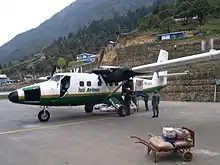Yeti Airlines Flight 103
Yeti Airlines Flight 103 was a domestic flight in Nepal, that crashed on final approach to Tenzing-Hillary Airport in the town of Lukla in eastern Nepal on 8 October 2008. The De Havilland Canada DHC-6 Twin Otter Series 300 registered as 9N-AFE originated from Tribhuvan International Airport in Kathmandu.[1][2]
 9N-AFE at Lukla in 2007 | |
| Accident | |
|---|---|
| Date | 8 October 2008 |
| Summary | Controlled flight into terrain due to inclement weather |
| Site | Lukla Airport, Nepal 27°41′13″N 086°43′47″E |
| Aircraft | |
| Aircraft type | De Havilland Canada DHC-6 Twin Otter |
| Operator | Yeti Airlines |
| Registration | 9N-AFE |
| Flight origin | Kathmandu Airport, Nepal |
| Destination | Lukla Airport, Nepal |
| Occupants | 19 |
| Passengers | 16 |
| Crew | 3 |
| Fatalities | 18 |
| Injuries | 1 |
| Survivors | 1 |
Aircraft
The aircraft involved in the crash was a de Havilland Canada DHC-6 Twin Otter operated by Yeti Airlines. Its maiden flight was in 1980 with Bristow Helicopters. The aircraft entered into service in Nepal in 1997, when Lumbini Airways acquired the plane. In 1998, Yeti Airlines bought the plane. In 2006, it already met with a minor incident, when the aircraft collided with a fence upon landing in Bajura Airport. It was involved in another incident, when the aircraft veered off the runway at Surkhet Airport in 2007.[3]
Crew and Passengers
Eighteen of the dead were reported to be tourists. Twelve of the passengers on the flight were German and two Australian. The only survivor was Surendra Kunwar, the captain of the aircraft, who was dragged free from the wreckage shortly after the crash and was flown to Kathmandu for emergency treatment.[1][4][5]
| Nationality | Fatalities | Survivors | Total | ||
|---|---|---|---|---|---|
| Passengers | Crew | Passengers | Crew | ||
| Nepal | 1 | 2 | – | 1 | 4 |
| Germany | 12 | – | 0 | – | 12 |
| Australia | 2 | – | 0 | – | 2 |
The pilot, being the only survivor, suffered psychological problems in the aftermath and was admitted to a psychiatric hospital.[6]
Crash
The airport is the main access to the Mount Everest region in Nepal, and is a notoriously difficult landing, with only 1,500 feet (460 m) of steeply sloped runway just 65 feet (20 m) wide and a steep approach path.[7]
Due to bad weather conditions and heavy fog, the pilot lost visual contact, nevertheless attempted a visual approach, as there are no Instrument landing systems installed at Lukla. The aircraft came in too low and too far left, which caused the aircraft to crash short of the runway, as the landing gear got caught in a perimeter fence on airport grounds.[8]
Aftermath

The safety regulations at Lukla airport were enhanced and landings in bad weather restricted. A plaque was put up near the crash site and the local people celebrate the victims' memory every year on 8 October.[6]
References
- Urs Wildermuth "Crash: Yeti Airlines DHC6 at Lukla, on October 8th, 2008, crashed on runway" Archived 6 December 2012 at Archive.today Aviation Herald 8 October 2008
- "Tourists die in Nepal air crasht". BBC. 8 October 2018. Retrieved 1 October 2018.
- "9N-AFE". Twin Otter Archive. Retrieved 1 October 2018.
- Bloomberg: Nepal Plane Crash Kills 18; Most Were German Tourists 8 October 2008
- Matt Johnston, David Hastie "Everest plane crash claims Australian couple" Archived 11 December 2008 at the Wayback Machine Herald Sun 9 October 2008
- "Tod von zwölf Deutschen: Der Horror-Crash von Lukla" (in German). Leipziger Volkszeitung. 6 October 2018. Retrieved 9 October 2018.
- "Everest plane crash kills 18 tourists in Nepal" Archived 11 October 2008 at the Wayback Machine Agence France-Presse 8 October 2008
- "Plane Crash Near Everest Kills 18". New York Times. 8 October 2018. Retrieved 1 October 2018.
External links
 Media related to Yeti Airlines Flight 103 at Wikimedia Commons
Media related to Yeti Airlines Flight 103 at Wikimedia Commons- Video of the crash taken from the airport
